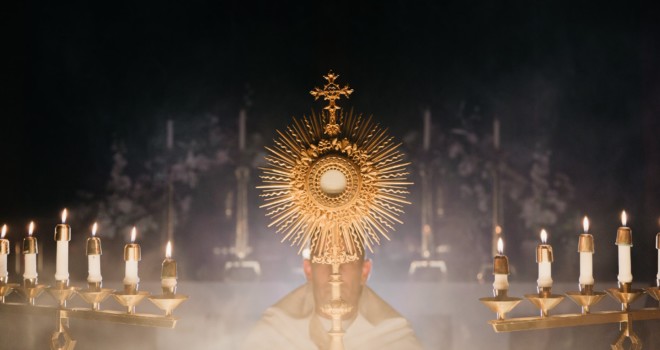A Eucharistic procession is a powerful way to bring Jesus’ love and peace to people. It is also a way to show Jesus our love for Him and to witness to Jesus’ love for us.
I never saw a Eucharistic procession until 2006 in England, having been born after the time when there were many processions in parishes and dioceses. The first procession I saw was a small one and very simple; after Mass on the Feast of Corpus Christi, the priest, holding a monstrance, led a group of children from the parish school and any parishioners who wanted to join them in walking around the parking lot of the parish.
The next procession I participated in was much larger, attracting Catholics from different parts of my diocese. It was held on the Feast of the Exaltation of the Holy Cross, with the intention of praying for an end to abortion and for religious liberty. It became an annual event over the last eight years, and I have been able to attend it almost every year. Catholics of all ages and of different backgrounds, including families with young children, single young adults, and seniors pray together, united by their faith in Jesus.
Traditionally, the procession begins in a church, with exposition of the Blessed Sacrament, and then the priest and lay people process through the streets of a poor area in the city, going past an abortion clinic, as we pray the Rosary and sing hymns. It concludes with Benediction in the church. Each year, I have been amazed by the way the people in the neighborhood respond to our procession. People of different religions and perhaps of no religion stand outside their houses and businesses to watch the procession; others pause for a moment as they walk out of a store or restaurant; drivers watch through their car windows as we cross the street. People smile and wave and seem truly happy to see us. One man driving by this year’s procession shouted, “thank you!” out the window of his truck. Whether or not they realize it or understand, I believe the people in this neighborhood are aware in some way that Jesus is with them. His presence brings them joy and peace.
In the last few years, I have participated in other Eucharistic processions: one to celebrate the Feast of the Sacred Heart of Jesus, another to pray for the protection of unborn babies from abortion, and another procession to honor Jesus on the Feast of Corpus Christi. Each procession was very beautiful and very reverent. As I walked and prayed with the others, I felt so joyful that Jesus was present with us in the Eucharist and that I am part of a community of other Catholics who share my faith in Him.
There are so many problems in our country and world that seem almost impossible to solve. So many people are suffering because they don’t know God. A procession is a powerful way to evangelize. Seeing a Eucharistic procession, which is an encounter with Jesus (whether or not they realize it) may lead people to think about God and perhaps start to pray. One memorable moment occurred during one procession I participated in. When we walked past a yoga studio in the business area of the city, a woman seeing us through the window quickly walked out the door, as though drawn to the procession, and asked someone what feast day it was. Perhaps she was a Catholic whose interests had led to her no longer practicing the faith, as has happened with some, and seeing the procession may been the beginning of her return to the Church. No one can know the extent of the good accomplished as the Blessed Sacrament is brought into a neighborhood in procession.
Over the last several months, Catholics in different dioceses have re-discovered the power of processions. On March 11, 2020, in response to the news of the coronavirus, Bishop Joseph Strickland of Tyler, Texas asked the priests in his diocese to lead simple processions around their church property before March 19, the Feast of St. Joseph. The intention was for protection from the coronavirus and healing for those who were sick, for God’s mercy for the people who had died, strength for families and fortitude for people to be guided by the truths of the Faith.
Soon afterwards, hundreds of other parishes and other dioceses in the United States also held processions for protection from the virus, which I believe had a positive effect. In August, a Catholic men’s group in the Madison, Wisconsin diocese organized a Eucharistic procession in the dioceses of Madison and Milwaukee, led by Bishop Donald J. Hying of Madison and Archbishop Jerome E. Listecki of Milwaukee to pray for peace in those cities and in the country. (This led to the founding of an organization to promote processions called Unite Our Nation, which has since organized 140 processions throughout the United States).
In September, the Archbishop of San Francisco, Salvatore Cordileone, organized Eucharistic processions to pray for an end to the restrictions on public Mass. On September 20, many Catholics in that city participated in three processions, concluding with an outdoor Mass at the Cathedral. On September 29, the city changed its regulations to allow indoor church services of up to 25% capacity, with a limit of 100 people. It is still overly restrictive, but the change in policy seems undoubtedly linked to the effect of the prayers of the people who participated in the procession.
A procession reminds us that people need God. If there are people who will not come to church, that we must go to them, letting them experience Jesus’ Eucharistic Presence and the joyful witness of His Catholic disciples.
✠
Photo by Jacob Bentzinger on Unsplash












